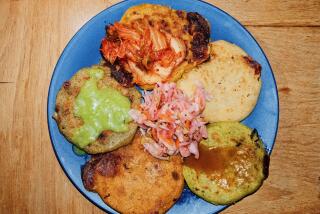A Taste of Rio Just South of the Border
- Share via
There are moments when Tijuana seems immeasurably more sophisticated than San Diego, and moments when it seems drab and cheerless; the trick, of course, is to catch it at the right time, an event not easy to prognosticate.
A good place at which to find Tijuana in its most European mood (the surprise is that any city in this area would have such a mood, but Tijuana can) is Plaza Fiesta, the instantly quaint Mexican village of small shops and restaurants that was built catty-corner to the Cultural Center several years ago as this city’s answer to Seaport Village.
Plaza Fiesta boomed when it opened and quickly became a gathering spot for the chic, the would-be chic, the young and, according to Tijuana sources, some segments of the underworld. A police crackdown cleared the winding byways about six months ago, and, on a recent Saturday, the place was relatively quiet.
If anything, there seem to be more restaurants than before in the maze-like collection of two-story buildings. There are at least 20 eateries, including not only Mexican houses but Italian, Greek and even Yugoslav, and, since virtually all of them feature live music, a stroll through Plaza Fiesta can make visitors feel like spectators at a monumental battle of the bands.
La Taberna Espanola, an authentic Spanish tapas bar run by Galicians, remains the most popular place by far, but right across the way is a tiny establishment called Oba Oba that flies a banner reading comida brasiliera . It takes about two seconds to translate this into “Brazilian food” and perhaps another two seconds to be seated at one of the seven tables in the minuscule but handsome dining room.
If one has not already had a sherry and a tapa at La Taberna, the way to start a meal here is with a caipirinha , a feisty cooler of sugar cane liquor, lemon juice and sugar that strolling vendors concoct on the beaches in Rio de Janeiro and that reputedly puts languid sunbathers on Copacabana Beach in the mood for another dip in the sea.
Oba Oba’s menu is written in Brazilian and translated into Spanish, so that anyone familiar with Mexican menus should find it easy to read; examples would be feijao , which translates into frijoles and beans, and queijo , or queso and cheese.
Starters divide into two competing categories, pasteis ( empanadas ) stuffed with cheese, shrimp or the hashed meat called picadinho ( picadillo ), and churrasquinhos , or skewers of marinated beef, chicken or pork cooked to a crusty finish on the grill. The latter are tasty but filling and are simply half-sized versions of the churrasco skewers offered as entrees. The empanadas , on the other hand, are alluring meat pies encased in flaky pastry; the shrimp version is a masterwork of subtlety whose suggestion of sweet-sour flavor vanishes if one thinks too much about it.
One can also start with a typical hearts-of-palm salad ( palmito ) or one of a trio of traditional soups, including very Brazilian chicken-with-vegetables ( canja de galinha ) and beans with spaghetti ( feijao con massa ). It is as well to begin on the light side, though, since entree portions can be formidable.
All the entrees are utterly typical and each plate seems engineered to be its own cornucopia; the only constant factors are the mounds of rice studded with peas and chopped carrots (it is excellent), the fried bananas and the little piles of farofa , a toasted flour that one sprinkles over anything and everything to add a slightly nutty taste and gritty texture. Farofa and Brazilian cooking are synonymous, and the stuff does have its moments, especially when added to the picadinho , the wonderfully savory and teasingly sweet hash of ground beef, tomatoes, onions and olives.
Another typical offering is tutu a mineira , a sort of buffet-on-a-plate of spicy chorizo-like sausage ( linguica ); a lacy fried egg; farofa -coated fried bananas; rice; a mound of black beans cooked down to a paste (Brazilians know that there’s more than one way to cook a bean); a peeled orange and a sensational pile of melting, chopped kale seasoned with enough cayenne to make a definite statement. The plate reads like a shopping list of favorite Brazilian foods and is a delight.
The dessert list offers flan out of a sense of obligation, but also pastel de goiabada e queijo , a fried, cinnamon-dusted empanada that combines the quince paste-cream cheese combination popular in many Latin countries.
Meals are priced reasonably, and three courses with wine, tax and tip should cost about $15 per person.
The tiny room is magically enlarged by a mirrored wall; another wall is taken up by a collection of carnival masks and, rather amazingly, room has been made for an upright piano. This recently was manned by a tuxedoed pianist who effortlessly moved from classical nocturnes to mean sambas to such dandy things as “Blue Moon (You Left Me Standing Alone).” With the food thrown in, this all added to an unexpected taste of Rio just south of the border.
Oba Oba is easily located. From the San Ysidro border crossing, follow the Zona Rio signs to Avenida Paseo de los Ninos Heroes and watch for the large Plaza Fiesta sign half-way around the first traffic circle.
DAVID NELSON ON RESTAURANTS
OBA OBA
Avenida Paseo de los Ninos Heroes 1001, Tijuana
Telephone: Tijuana 85-10-11
Credit cards accepted.
Lunch and dinner served Tuesday through Sunday; closed Monday.
More to Read
Sign up for The Wild
We’ll help you find the best places to hike, bike and run, as well as the perfect silent spots for meditation and yoga.
You may occasionally receive promotional content from the Los Angeles Times.






